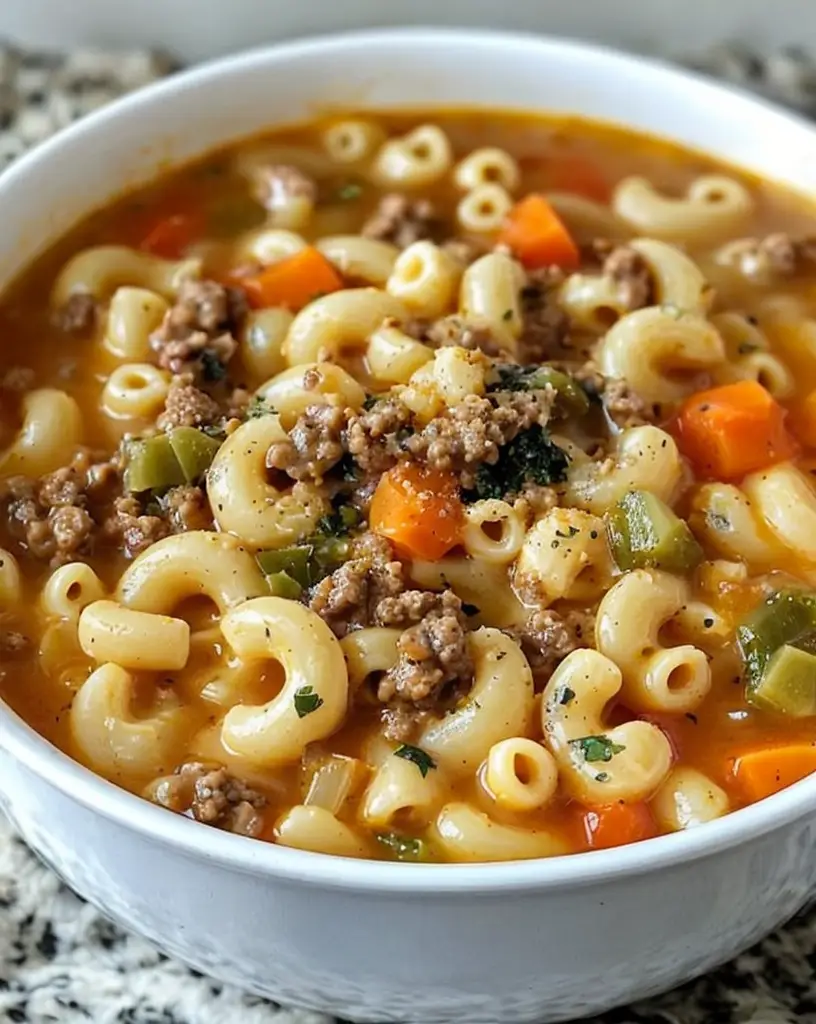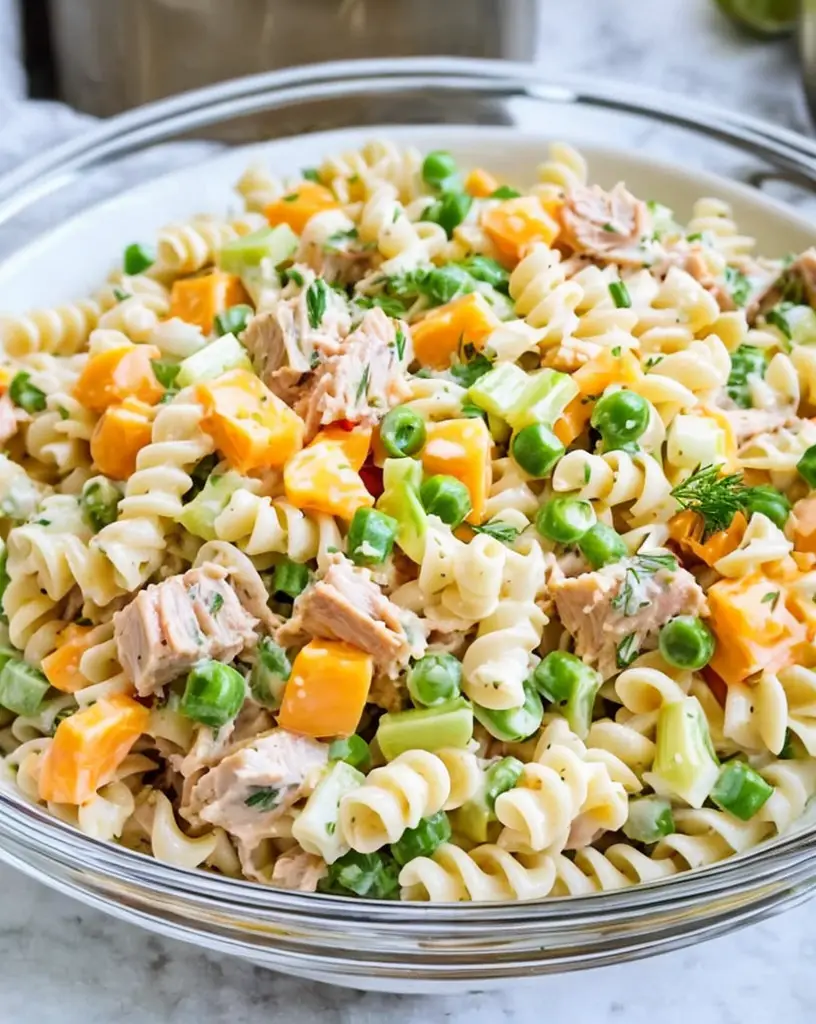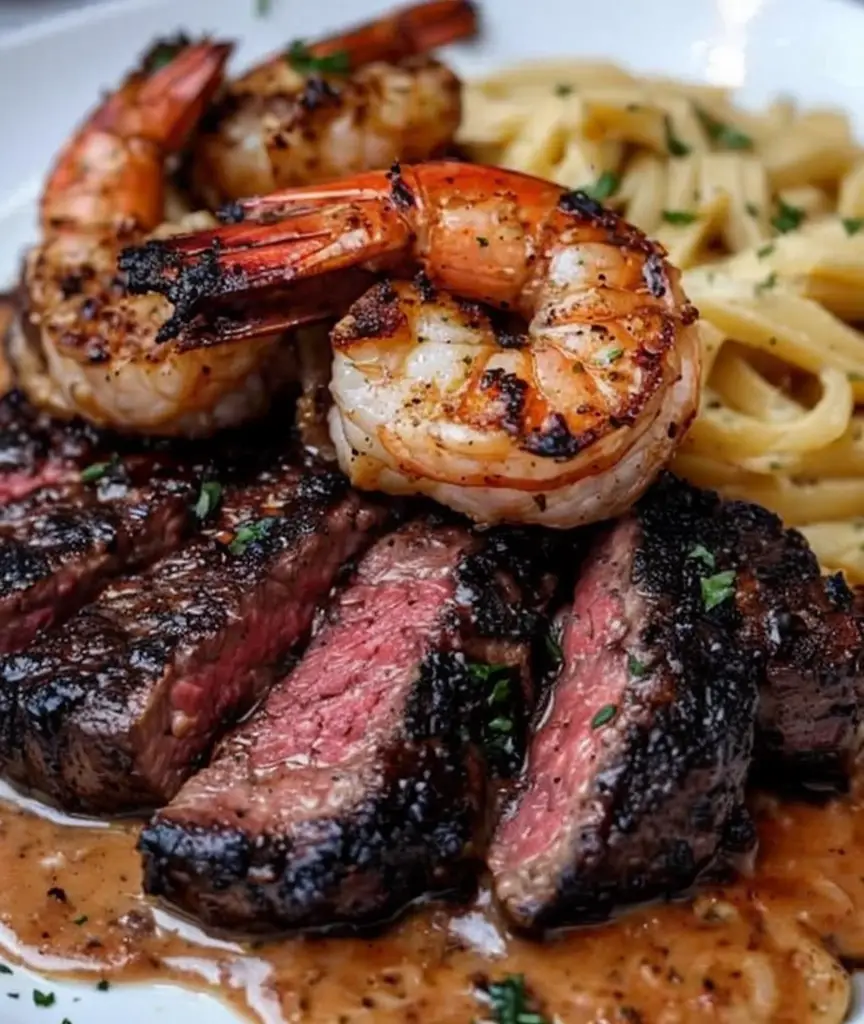One-Pot Macaroni Cheeseburger Soup: Cozy Comfort in a Bowl
Imagine a chilly fall evening, enveloped in a cozy blanket, as you savor a bowl of One-Pot Macaroni Cheeseburger Soup. This delightful dish combines the classic flavors of a cheeseburger with the comforting warmth of a soup, making it an irresistible meal for soup enthusiasts and burger aficionados alike. Perfectly seasoned beef, tender macaroni, and rich, melty cheese come together to create a savory symphony that warms the soul.
The One-Pot Macaroni Cheeseburger Soup is an excellent example of comfort food at its best. This recipe is not only heartwarming but also convenient, as it simplifies cleanup by requiring only one pot. It is a perfect dinner option for busy weeknights, ensuring you can enjoy a wholesome, homemade meal without spending hours in the kitchen. Serve this comforting bowl of deliciousness with a slice of crusty bread for an extra touch of indulgence.
Quick Recipe Highlights
- Flavor Profile: Savory cheeseburger essence with hints of tomato and mild spices, delivering a comforting, home-cooked taste
- Texture: Creamy and hearty, with tender macaroni and juicy beef in every spoonful
- Aroma: Warm, inviting notes of cheese and herbs fill the kitchen as it cooks
- Visual Appeal: Vibrant yellows from the cheese, coupled with the rich browns of beef and specks of green herbs
- Skill Level Needed: Simple enough for beginner cooks, with straightforward steps and ingredients
- Special Equipment: Requires only a large pot or Dutch oven
Recipe Overview
- Difficulty Level: This recipe’s simplicity lies in its one-pot method, minimal prep, and everyday ingredients, making it accessible to novice cooks.
- Category: Perfect as a main course or hearty lunch, ideal for family meals.
- Cuisine: Inspired by American classics, blending the beloved burger elements with creamy soup.
- Cost: Affordable and budget-friendly, utilizing common pantry staples and inexpensive proteins.
- Season: Best enjoyed in fall and winter for its warming, satisfying qualities.
- Occasion: Great for casual dinners, family gatherings, or potlucks.
Why You’ll Love This Recipe
Taste and texture come together beautifully in the One-Pot Macaroni Cheeseburger Soup. Each spoonful delivers a satisfying blend of flavors that mimic a classic cheeseburger, without the need for a bun. The rich, creamy texture paired with soft macaroni and juicy beef makes every bite a delightful experience.
Convenience is key in this recipe, saving you time and reducing cleanup by using a single pot. It’s a dinner option that lets you relax and enjoy more time with family or friends, while the soup simmers to perfection on the stove. Plus, most ingredients are likely already in your kitchen, making this meal even easier to prepare.
Nutritionally, this soup offers a balance of protein and carbs, providing a filling meal that satiates hunger and satisfies taste buds. Adjusting cheese amounts or incorporating additional vegetables can further enhance its nutritional value to meet personal dietary needs.
Socially, this soup is a conversation starter, making it perfect for entertaining. Its unique concept of transforming a beloved fast-food item into a gourmet soup invites discussions about culinary creativity and food fusion.
Cost-effectiveness is at the heart of this dish, as it relies on affordable ingredients such as ground beef, macaroni, and cheese, making it a great option for anyone looking to feed a family on a budget without compromising on flavor.
Historical Background and Cultural Significance
The origins of the One-Pot Macaroni Cheeseburger Soup are rooted in the American culinary tradition, where comfort food reigns supreme. It brings together two iconic American staples—macaroni and cheese, and hamburgers—into a single, cohesive dish that appeals to young and old alike.
Culturally, this dish signifies the ongoing evolution of American cuisine, where experimentation and blending of popular foods lead to new, exciting recipes. The soup speaks to the inclination towards dishes that are hearty yet convenient, reflecting a modern lifestyle while honoring classic tastes.
Over the years, this recipe has evolved, with home cooks adapting it to include various spices, vegetables, and cheeses, reflecting regional tastes and availabilities. Some variations even incorporate bacon or pickles, further enhancing the authentic cheeseburger experience.
Across different regions, the soup might display variations, with possible inclusions like jalapenos in Southern versions or added mushrooms in Northern adaptations. Each rendition offers its unique twist, showcasing local flavor preferences while maintaining the foundational flavors of the original concept.
Ingredient Deep Dive
Ground beef serves as the cornerstone of this dish, infusing it with a rich, savory profile reminiscent of a traditional hamburger. A staple in American diets, ground beef is a versatile protein that’s economically accessible and rich in essential nutrients like iron and B vitamins. When selecting ground beef, opting for lean cuts can reduce fat content while maintaining flavor integrity.
Macaroni, a small, tube-shaped pasta, is critical to achieving the hearty texture in this soup. Its Italian origins are evident, yet it has become an integral element of American cuisine, largely due to its adaptability and quick-cooking nature. Store sealed in a cool, dry place to preserve freshness and avoid clumping.
Cheddar cheese adds the creamy, cheesy finish essential to replicating the cheeseburger experience. This British-origin cheese has become a fan-favorite in American cooking due to its robust flavor and excellent melting qualities. For the best results, choose aged cheddar for a bolder taste, and grate it fresh to enhance meltability.
Strong aromatics like garlic and onion provide a base of flavor, enhancing the meatiness of the soup. When fresh garlic and onions are unavailable, powdered versions offer a convenient alternative without sacrificing much flavor. Store in a cool, dark pantry to maintain potency.
Common Mistakes to Avoid
- Overcooking the macaroni can lead to a mushy texture, so add it towards the end of the cooking time.
- Underseasoning the beef diminishes the overall flavor. Ensure adequate seasoning with salt, pepper, and spices.
- Adding cheese before sufficient cooling can result in a grainy texture. Allow the soup to slightly cool before stirring in the cheese.
- Choosing canned beef broth with high sodium levels can overwhelm flavors. Opt for low-sodium options to control seasoning.
- Skipping browning the beef can lead to a bland and greasy soup. Brown beef properly to enhance taste and texture.
- Ignoring the simmering step can cause thin soup consistency. Be sure to simmer long enough for flavors to meld and thicken.
- Using pre-shredded cheese can result in poor melting due to anti-caking agents. Grate your own cheese for optimal results.
- Failure to stir during cooking can cause ingredients to stick or burn. Regular stirring ensures even cooking and consistent texture.
Essential Techniques
Browning the beef is a crucial step in this recipe, enhancing the soup’s depth of flavor. Ensure the beef is cooked on medium-high heat to achieve a perfect browning, which seals in juices while creating a savory base. Use a heavy-bottomed pot to evenly distribute heat and prevent sticking.
Timing the addition of ingredients like pasta and cheese is paramount for texture and taste. Macaroni should cook just until al dente, as it will soften further in the soup’s heat. Cheese is best added off-heat, stirring gently to create a creamy consistency without curdling.
Thickening the soup requires a gentle simmer. Allow the soup to simmer at a low, steady pace after adding all ingredients. This process blends flavors and naturally thickens the base, resulting in a satisfying mouthfeel. Avoid boiling to maintain the creamy texture and prevent ingredient breakdown.
Pro Tips for Perfect One-Pot Macaroni Cheeseburger Soup
Ensuring your beef is finely crumbled during cooking will yield a uniform texture throughout the soup. Use a fork or spatula to break down larger chunks as the beef browns.
Fresh herbs like parsley or chives add a pop of color and flavor when sprinkled on top just before serving. A small addition that makes a visual impact, playing up the soup’s appetizing appearance.
If you prefer a spicier version, incorporate chili flakes or jalapeños during the beef browning step to infuse the soup with heat, adjusting the spice level to fit your taste.
To achieve a heartier texture, incorporate diced tomatoes or bell peppers. Sauté these along with onions to release natural sweetness, which complements the savory components of the soup.
Experimenting with different cheeses can lead to exciting flavor variations. Consider mixing in a bit of smoked gouda for a subtle depth or Monterey jack for a milder profile.
When cooking for a crowd, batch-cooking this soup ahead of time is a game-changer. Reheat over low heat to gently return it to serving temperature, ensuring flavors remain intact without overcooking the pasta.
Variations and Adaptations
Regional variations add personality to this versatile recipe. Try a Southern twist by adding bacon and green onions, creating a familiar, down-home flavor profile. Or explore a Midwest version with mushrooms and Worcestershire sauce for an umami boost.
Adapting this recipe to different seasons is easy; incorporate seasonal vegetables such as zucchini in summer or butternut squash in fall. This approach ensures freshness and highlights local produce availability.
Dietary modifications like using gluten-free pasta or dairy-free cheese options cater to specific needs without compromising on flavor. Explore plant-based ground meat alternatives, maintaining texture while accommodating vegetarian or vegan diets.
Flavor variations can include incorporating barbecue or hot sauce for a bold kick, appealing to those looking for adventurous bites. Alternatively, experimenting with various herb blends, like Italian seasoning or Cajun mix, can offer new dimensions.
For a textural twist, include croutons or crispy fried onions as a topping, adding a delightful crunch that contrasts the creamy soup. Consider mixing in quinoa or barley for a texture shift while enhancing nutrition and chewiness.
Presentation alternatives include serving the soup in a bread bowl, offering an interactive, edible vessel experience. This method adds visual appeal and suggests a rustic, cozy dining setting suitable for casual gatherings or themed dinners.
Serving and Presentation Guide
Mastering the plating of One-Pot Macaroni Cheeseburger Soup requires minimal effort but impactful results. Serve in deep bowls to retain heat and capture the hearty look, encouraging immediate appetites.
Garnishing with fresh chopped parsley or a sprinkle of grated cheese invites vibrant colors, while an additional drizzle of mild olive oil or cream elevates the presentation, adding an elegant touch.
Traditional accompaniments like a side of crusty bread or a small green salad provide balanced nutrition alongside satisfying, hearty bites.
Modern serving suggestions might include individual-sized portions in ramekins or small skillets, perfect for elegant dinner parties while ensuring uniform presentation and ease of dining.
Temperature considerations suggest keeping the soup warm without boiling, preserving the creamy consistency. Pre-warming serving bowls enhances dining pleasure, as it extends the moment of the first delicious bite.
Portion control tips suggest serving the soup with smaller portions of rich sides, such as cheese-topped toasts, ensuring a balanced meal that indulges without overwhelming, making it suitable for guests mindful of intake.
Wine and Beverage Pairing
Wine pairing with Macaroni Cheeseburger Soup can enhance experience, with medium-bodied reds like Merlot complementing the richness perfectly. The fruity notes balance the depth and creaminess of the soup.
For non-alcoholic alternatives, consider light herbal teas or flavored sparkling water with citrus, as they cleanse the palate and highlight the soup’s savory elements.
For those inclined towards coffee pairings, a smooth medium roast complements the creaminess, offering a comforting meal conclusion.
Serving suggestions for beverages include chilled wines or room-temperature teas, providing a refreshing counterbalance to the soup’s warmth, enhancing flavor interplay.
Storage and Shelf Life
Proper storage extends the soup’s shelf life elegantly. Use airtight containers to prevent moisture and odor absorption, refrigerating promptly once cooled to maintain freshness.
Temperature requirements suggest refrigeration for 3-4 days, ensuring consistent texture and safety. For extended storage, consider dividing into portions, freezing for up to 3 months.
Recommended containers are glass for neutral odor retention, or BPA-free plastic for lightweight travel convenience.
Signs of spoilage include sour smell or off-coloration; discard if these appear to ensure safety. Reheat gently over low heat, stirring to avoid separation and reserving full flavor impact.
For freezing, tolerate minor texture changes by slightly undercooking the pasta initially, ensuring firmer consistency post-thaw, with reheating options like stove or microwave available.
Make Ahead Strategies
Master make-ahead techniques by preparing ingredients separately. Cook ground beef and mince vegetables up to 2 days in advance, storing them separately to maintain texture and freshness.
A sensible storage timeline involves refrigerating prepped elements and combining them on cooking day, reducing day-of commitment while retaining the soup’s integrity.
Quality assessment should include ingredient examination, avoiding losses. Assemble the soup progressively, following a structured add-in order to ensure flavor continuity.
Reheating is best on low, allowing gradual thickening without haste. Add fresh herbs or cheese once reheated to restore vibrancy and aroma, reminiscent of first-day preparation.
Scaling Instructions
Scaling recipes effectively requires precision. When halving, maintain ingredient proportions closely, using smaller pots for depth and attention to cooking times.
Doubling demands larger pot accommodations, ensuring heat distribution remains consistent for even seasoning and texture. Extend cooking time by minutes, observing pasta for al dente stage finely.
Adjust kitchen equipment by incorporating additional utensils or implements, avoiding cross-contamination or flavor dilution with scaled ingredients.
Storage remains a priority; divide portions accordingly, embracing refrigerator space for fresh storage and freezer solutions for longer-term mining.
Nutritional Deep Dive
Exploring Macaroni Cheeseburger Soup’s nutritional landscape reveals a balanced macro breakdown. Protein, carbs, and fats derive mainly from beef, macaroni, and cheddar, making a mid-range calorie option.
Micronutrient analyses show strong iron and calcium content from beef and cheese, supporting bone health and energy levels. Nutritional benefits extend to digestive balance attributed to fiber.
Dietary considerations invite balance with additional veggies or substituting reduced-fat cheese options; these alter nutrient content while preserving core flavors and satisfaction.
Portion analysis assures gratifying servings without overconsumption. Considering weight management tips, align soup consumption within broader dietary structure aligning with individual health goals.
Dietary Adaptations
Gluten-free adaptations can include corn or rice pasta substitutes, levying taste and texture similar to classic macaroni minimizing gluten intake.
Dairy-free benefits rely on plant-based cheeses or nutritional yeast for cheese flavor, using almond milk for creamy consistency resolved without dairy. Vegan choices extend to utilizing lentils for protein, effectively creating vegan-friendly indulgence, highlighting flavor complexity.
Exploring low-carb alterations like using spiralized zucchini invites hearty satisfaction without glycemic impact; keto variations could capitalize on cream and moderate cheese cheese inclusion for full-bodied stew dynamics.
Range of modifications like Paleo influence or low-FODMAP adaptation creates accessibility, ensuring all diners enjoy a harmonious meal experience without dietary limitations.
Troubleshooting Guide
Texture issues typically arise from overcooking pasta, resolved by careful monitoring and controlled timing, ensuring desired al dente outcome distinctively remains.
Flavor balance considerations revolve around incremental seasoning adjustments—sensitive taste testing should accompany gradual additions to avoid overpowering cheesiness or saltiness.
Temperature problems often occur if soup boils during cheese addition, remedy suggesting immediate stir-off-heat technique; correcting curdling malfunctions effortlessly.
Equipment challenges manifest through inadequate pot sizes, fixed by aligning scale adjustments with kitchen implements adequately accommodating batch size, preserving safety and cooking precision.
Ingredient substitutions, such as alternative protein sources, necessitate texture consideration, with larger beans or tofu cautiously incorporated, sustaining consistency and vibrancy.
Timing concerns alleviate by organizing stages, reducing overlaps and maximizing control; reinforced with written guides reminding best approaches, outcomes align closely with posted intentions.
Recipe Success Stories
Community feedback garners significant positivity, evidenced by enthusiastic praise for its fusion success blending classic tastes with innovation, verbalized by diverse culinary backgrounds favoring sensory experiences culminating in enlightening satisfaction.
Variation successes feature elevated elements like supplementary bacon or jalapeños, creating visionary takes surpassing expectations. These express beloved classics, resulting in regional differences emphasizing cultural harmony.
Adaptation stories include family preferences accounted for, such as leaner protein choices for heart-health prioritization, immediately embraced by eager diners anxious to taste modifications seamlessly combining tailored ingredients with existing anticipations.
Reader suggestions have gracefully enriched horizons; photography tips inspire visual storytelling interwoven with dynamic culinary expression captivating online sharing communities.
Frequently Asked Questions
What type of beef is best for this soup? Ground beef with around 80-85% lean content is ideal, offering a balance between flavor and fat. Leaner versions work too, but may need extra oil for browning, minimizing dryness.
Can I make this soup vegetarian? Yes, simply substitute plant-based ground meat or lentils and use vegetarian alternatives for cheese, creating a harmonious plant-based variation with texture intact.
Is it feasible to double the recipe? Absolutely; just ensure an appropriately sized pot is used to maintain even ingredient distribution. Adjust pasta timing to reach desired consistency, effectively scaling flavor profiles.
How long does this soup last? The soup remains fresh in the refrigerator for 3-4 days, ensuring storage in airtight conditions to preserve flavor integrity. Freeze for later enjoyment within three months.
Can I substitute the cheddar cheese? Yes, other cheeses like gouda or mozzarella offer delightful substitutes, each contributing their unique profiles towards distinctively modernized taste experiences.
Is it possible to make this soup ahead? Absolutely; prepare individual elements such as browning beef or chopping vegetables beforehand, enabling swift soup preparation upon assembling delightfully vibrant final outcomes.
How should I reheat the soup? Reheat gently over low heat, stirring occasionally to prevent scorching and separation. Evoke fresh aroma with herbs or additional cheese just prior to serving.
Which pasta is best for gluten-free adaptation? Opt for quinoa or brown rice pasta, aligning with texture needs accurately while remaining gluten-free compliant, fortifying culinary experiences.
What should I do if my soup is too thick? Thin the soup gently with warmed broth or water, stirring until desired consistency is reached. Adjust seasoning if needed to ensure balanced flavors.
What are suitable accompaniments? Serve alongside crusty bread for dipping or a crisp side salad to balance the indulgent richness with fresh, light flavors complimenting meal satisfaction perfectly.
Additional Resources
Explore related recipes merging creative soup endeavors with modern classics, offering new perspectives and serving inspiration inspired directly through beloved culinary traditions.
Dive deeper into ingredient information; perceive each item’s impacts in culinary realms and dietary considerations, establishing knowledge bases for innovative adaptation and creative exploration.
Technique guides enhance mastery, empowering readers with seasoned tips that seamlessly translate intentions into successful culinary executions, imbibed by expansively shared expertise throughout profound collections.
Equipment recommendations facilitate ease across achievable home cooking during elegant creation, ensuring full engagement without hinderance from limitations, thereby effectively amplifying professional feel throughout entire meal preparation seamlessly.
Seasonal variations concepts spark culinary imagination, leading towards re-envisioned meals attuned to unique growth cycles, providing wider enjoyment pathways year-round directly aligned with production.
Join the Conversation
Engage with the Macaroni Cheeseburger Soup community, sharing your photos and experiences on social platforms. Inspire fellow foodies by sending feedback and suggestions on how you adapted social events.
Boost photography abilities through leveraging lighting and perspective tips, resulting in captivating culinary storytelling adored across digital spaces.
Provide insightful reviews based upon try-and-observe tactics encountered during recipe implementation, yielding constructive dialogue owing to cognitive sharing, illuminating continued enjoyment collectively.
Create interactivity with fellow enthusiasts discussing variation ideas unlocking fresh possibilities; enrich collective understanding incorporating wide-ranging visions expressed through open-minded dialogues.
Ultimately connect thriving participation alongside digital community enhancement processes, esteemed reciprocation keeping engagements rich, evermore strengthening culinary network interactions aesthetically and communicatively unified.
The Recipe
One-Pot Macaroni Cheeseburger Soup
Serves: 6
Prep Time: 15 mins
Cook Time: 25 mins
Total Time: 40 mins
Kitchen Equipment Needed
- Large pot or Dutch oven
- Wooden spoon or spatula
- Measuring cups and spoons
- Grater for cheese
Ingredients
- 1 lb ground beef
- 1 onion, diced
- 2 cloves garlic, minced
- 4 cups beef broth
- 2 cups macaroni
- 1 can diced tomatoes
- 2 cups shredded cheddar cheese
- Salt and pepper to taste
- 1 tsp paprika
- 1 tbsp olive oil
Directions
- Heat olive oil in a large pot over medium heat. Add onions and garlic, sautéing until translucent.
- Add ground beef, cooking until browned. Season with salt, pepper, and paprika.
- Stir in beef broth and bring to a boil before adding macaroni.
- Reduce to a simmer, cooking macaroni until al dente.
- Stir in diced tomatoes and remove from heat. Gradually add cheddar cheese, stirring until melted and creamy.
- Serve hot, garnished with parsley or extra cheese if desired.
Recipe Notes
- For a spicier version, add cayenne pepper or red pepper flakes.
- Vegetarians can replace ground beef with textured vegetable protein.
- Leftovers can be stored in the refrigerator for up to 3 days.










